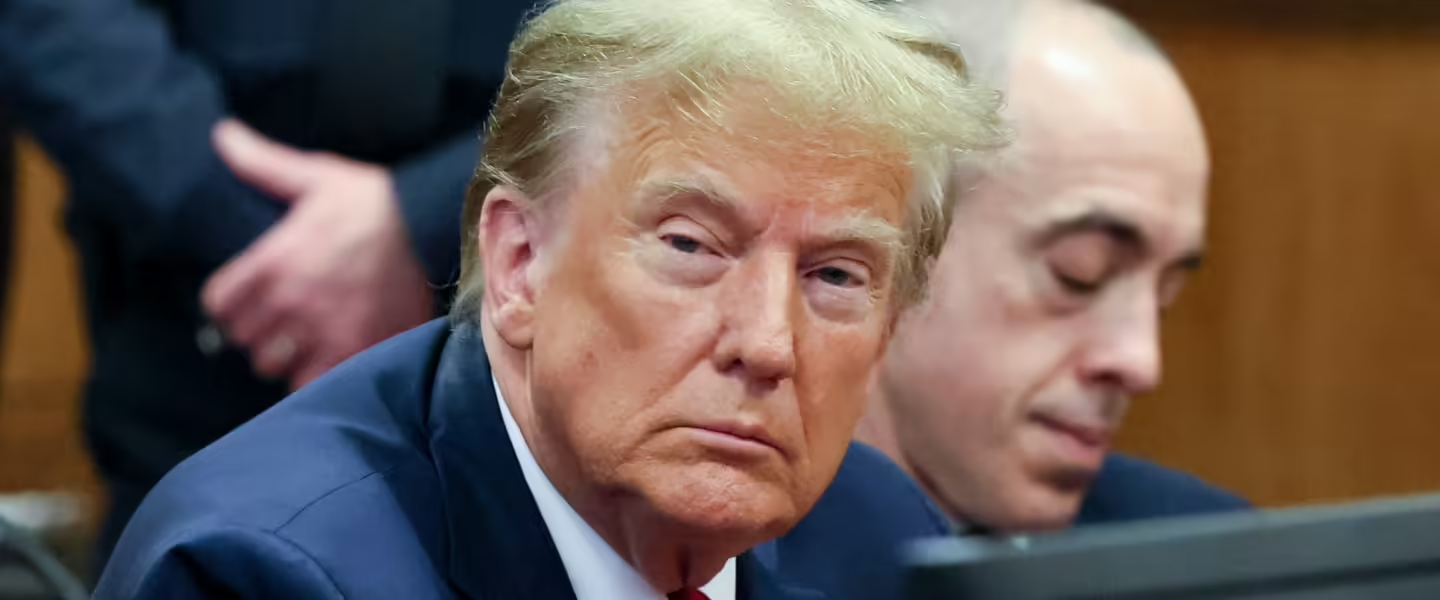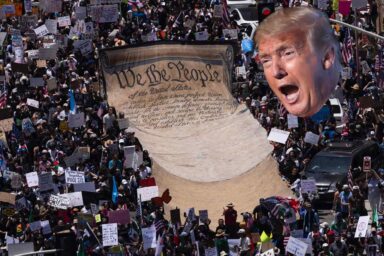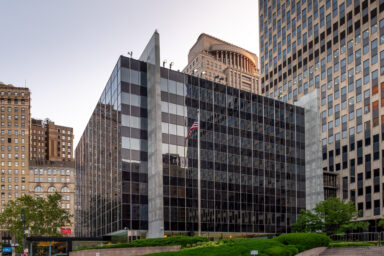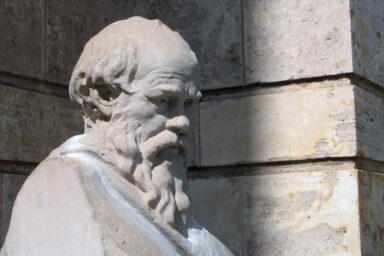It is what it is — and it is all there is.
|
Listen To This Story
|
With jury deliberation underway in Donald Trump’s New York state criminal trial, there’s still no real agreement on either the likely outcome or the electoral impact of whatever the outcome may be.
It seems that nothing connected to Trump can fail to be divisive, and the legal merit and political significance of his trial are no exception.
From the beginning, observers and commentators, including the biggest guns, have been all over the lot on the most basic questions, such as whether the case should even have been brought, the motives for bringing it, its likely outcome, and its impact on voters. At this late date, the media still can’t quite figure out whether to call the thing a “hush money” trial, a “falsification of business records” trial, or an “election interference” trial.
And that utter lack of consensus prevails as you delve deeper into the legal weeds: Some have depicted a case full of holes, driven by zealous and partisan prosecutorial overreach, while others have saluted the stepwise logic by which Manhattan DA Alvin Bragg built a raft of felony indictments out of the raw material of misdemeanors.
Experts Go Toe to Toe
What makes it even more interesting — and perplexing for anyone sitting in the bleachers with a scorecard — is that, unlike with most things Trump, the split on this trial and its merits freely crosses the great political divide.
To wit — one of many examples — last month The New York Times published a guest op-ed by Boston University law professor Jed Shugerman entitled “I Thought the Bragg Case Against Trump Was a Legal Embarrassment. Now I Think It’s a Historic Mistake.” The headline makes clear, without going into the gory details, what Shugerman thought of the case and the trial. His analysis, which is worth reading, was highly sophisticated, yet its bottom line was not too far off from the charges leveled against Bragg by Team Trump.
But Shugerman, who holds both a JD and a PhD from Yale, is no MAGA, not even close. He has solid liberal credentials (including, according to his blog, a perhaps dubious encomium as “a rare honest liberal scholar” from none other than Kenneth Chesebro, whom you may recall as one of the architects of Trump’s “fake elector” scheme). He co-authored an anti-Trump amicus brief in the CREW v. Trump case, alleging the then-president’s violation of the Constitution’s Foreign Emoluments Clause.
Shugerman’s critique would, I’m pretty sure, be persuasive to a casual reader. Even with the benefit of my own JD, I found myself way more worried in its wake that Trump would emerge acquitted, “vindicated,” and, most likely, president.
Then I tuned into a Q&A session by Washington Post columnist Jennifer Rubin, who was asked about the Shugerman piece and responded thus:
The opinion piece is poorly reasoned and seems not to have tracked the court proceedings. Contrary to his accusation of “vagueness,” the scheme of election interference was amply detailed in the prosecution’s opening argument.
Shugerman misconstrues the case; the judge already approved three statutory grounds for elevating the crime to a felony. None of them is “election fraud”; that was the PURPOSE of the scheme. The law was broken when he violated three statutes (tax law, state and federal election law) by mischaracterizing the payments as legal fees. It is those three violations that elevate the case to felonies.
How, you may ask, does a mere columnist like Rubin come off taking a legal luminary like Shugerman out to the woodpile? Well, it turns out that Rubin is not only a fellow attorney but graduated first in her class from the elite UC Berkeley School of Law, no mean feat.
And there you have it. I’ve presented Shugerman and Rubin’s views for the purpose of illustration. They are dots in the galaxy of opinions out there when it comes to assessing the New York trial, from the tiniest legal nuts and bolts to the ultimate electoral impact. They also serve as an explanation, of sorts, for why I’m slow to crown a winner of the debate.
Instead, I want to step back a bit and contemplate where this trial fits in the Wagnerian Ring Cycle that is Election Year 2024, with Trump its wannabe Brunhilde.
It Happened One Night
Let’s begin with the genesis of the case. For all of its legal novelty, this prosecution essentially derives from and centers on the same scheme for which one-time Trump fixer Michael Cohen had already been tried in federal court, convicted, and sent to prison. It fell to Bragg as a state matter only because the US Department of Justice, which had pursued Cohen, was pulled off its parallel investigation of Trump’s role.
That investigation was stymied — according to the account of Geoffrey Berman, the prominent (Republican) US attorney for the Southern District of New York who was in charge of it — by the intervention of Attorney General Bill Barr, who not only had a long history as a GOP fire chief but who, throughout his tenure, ran interference for Trump, often acting more like his personal attorney than the public’s attorney general.
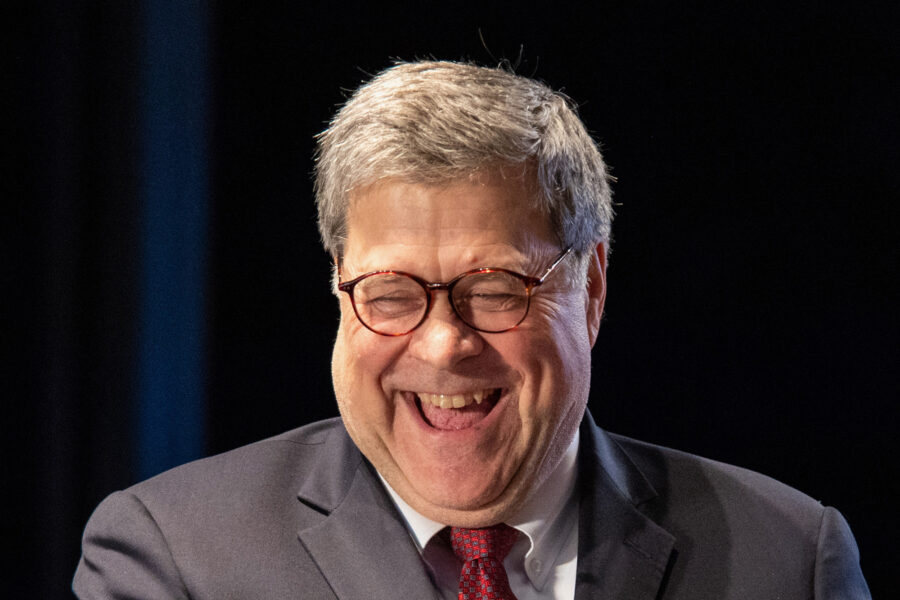
It’s a stretch to think that Cohen committed the crimes for which he was punished for his own health; there is little doubt whose interests he was serving. The DOJ has a policy against indicting a sitting president, but no policy stands in the way of completing an investigation. Spiking it was Barr’s work. After power changed hands in January 2021, it fell to Joe Biden’s attorney general, Merrick Garland, to pick up the Trump “hush money, campaign finance, election interference” trail. But Garland, as in the case of Trump’s January 6 activities, in the face of numerous practical challenges and resistance from his own FBI, proved reluctant to engage in what he apparently feared would be regarded as “political” prosecution, and let the whole thing drop, which meant it was down to New York state.
Departing Manhattan DA Cyrus Vance had the good sense to get out of Dodge and back into lucrative private practice with his office’s investigation still “in process.” Which left it to his successor, Bragg, who — elected on something of a “bring Trump to justice” platform — began his tenure in 2022 by putting the brakes on his office’s parallel criminal investigation into Trump’s business practices, causing two prominent assistant DAs who’d been developing the case under Vance to resign in frustration.
Bragg came to embrace the falsification case slowly and carefully, after doing much of his own diligent research. Contrary to the charges of partisan zealotry coming from Team Trump, Bragg was hardly champing at the bit. He was quite aware of the obstacles arrayed in the path of the prosecution at every stage: investigation, indictment, and trial.
Not a Circus — Despite Trump’s Act
All things considered, one would thus far have to rate the trial a pleasant surprise for Bragg, the People of the State of New York, and those hoping for at least a smidge of legal accountability for the former president before the matter of his fitness is put to the voters in November.
New York Supreme Court Justice Juan Merchan has handled an unprecedented proceeding and a string of potentially explosive challenges fairly and firmly. Trump has been given much more leeway than would have been accorded to an ordinary defendant but has not succeeded in making a mockery of the proceedings or forcing a mistrial to be declared.
https://twitter.com/Spawn_03/status/1793459419361030190
A jury was empaneled with surprising rapidity, all concerned having recognized that finding jurors wholly ignorant of Trump’s existence and behavior — before, during, and after his presidency — was a practical impossibility. The bar was thus lowered to a statement and some showing of a capacity to view the evidence presented impartially. From the point of opening arguments forward, all selected jurors and alternates have remained on the case, not something to be taken for granted in a trial of this length, import, and stress level.
Cutting through some technicalities, the prosecution sought to establish that Trump caused business records — the designation of checks written to Cohen — to be falsified, in furtherance of a scheme to pay “hush money” to prevent the public from learning, before the 2016 election, about porn star Stormy Daniels’s allegations of Trump’s extramarital sexual encounter with her. Ancillary issues concerned campaign finance and tax laws.
If that description of the case seems a bit sketchy, therein lay the major problem for the prosecution and the source of much of the skepticism from critics like Shugerman.
But as the trial has unfolded, most experts have given the prosecution high grades for putting on a strong and reasonably coherent case, generally getting the most from their witnesses, and making few unforced errors. The defense, amidst widespread speculation that Trump himself was calling many of the shots and demanding numerous questionable lines of attack, has at several key points elicited expert commentary to the effect of “What are they thinking?” and “That’s a shocking rookie mistake.”
For just a couple from a pile of examples: By standing on Trump’s denial of sexual relations with Daniels, the defense gave the prosecution the opportunity to question Daniels in great detail about her evening with Trump — spanking, Hefneresque outfit, and boorish behavior included. Then the defense, which had failed to register expected objections to this whole line of questioning, moved for a mistrial, which the judge denied, citing the defense’s perplexing failure to object.
And, although the cross-examination of Daniels by defense attorney Susan Necheles was withering, it wound up giving Daniels the opportunity to score points at Trump’s expense. Pressing Daniels on her pecuniary motives in selling case-related merch, for example, drew a simple “Not unlike Mr. Trump” in response.
Not bad as four-word answers go. It is hard to believe that an experienced attorney, which Necheles is, would throw such stones from the glass house in which Trump has lived his whole life, unless at her client’s command.
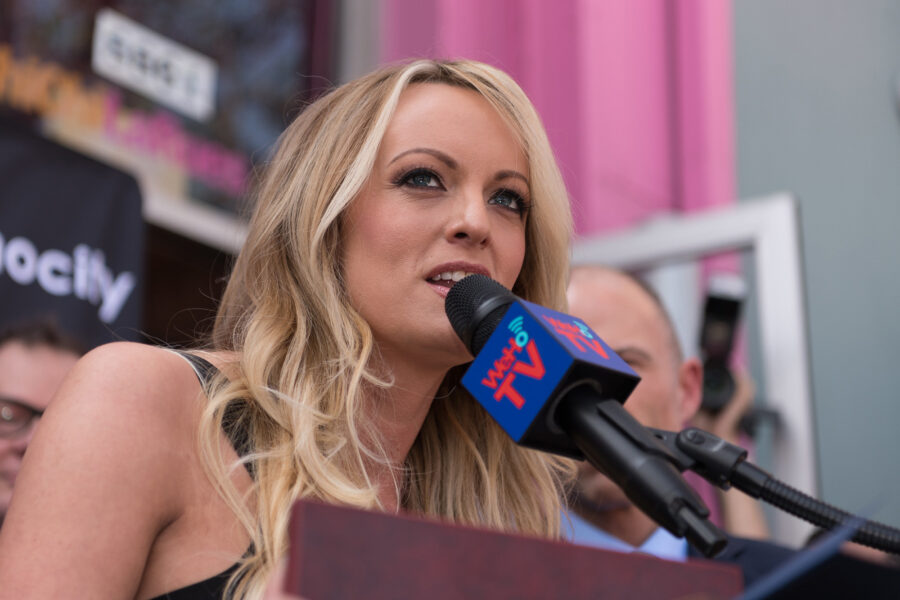
A well-conceived defense would have effectively precluded the whole, rather sordid Daniels chapter — since neither the alleged sex nor the hush-money payments were crimes in and of themselves — and kept the focus on the issue of whether Trump in fact was responsible for ordering or causing the falsification of records that is the essential first element of the charged crime. Although there was circumstantial documentary evidence on this point, the prosecution’s case nevertheless relied heavily on the corroborative testimony of Cohen, a convicted perjurer who freely acknowledged lying at many points in his career as Trump’s “fixer.”
But Cohen stood up very well to aggressive cross-examination, his demeanor calm and pointedly non-evasive throughout. As with Daniels, the defense scored a few points, but the overall impression was of solid witnesses who had each in their own manner paid significant dues and understandably had little compunction about telling their stories in the service of justice. If that meant nailing Trump, well hey!
Other prosecution witnesses, such as National Enquirer publisher David Pecker, spoke to Trump’s modus operandi when it came to shielding his reputation — specifically, the “catch and kill” method of burying salacious stories. This served to put the alleged crime in context, exposing, for anyone who didn’t already know, a louche and reckless man with all sorts of skeletons to hide.
The defense attempted to argue that Trump paid the hush money to Daniels and others because he wished to “protect his family” from what he maintained were false allegations and shakedowns, and not to influence the 2016 election. This claim — given Trump’s hardly secret decades of womanizing — is unlikely to be persuasive, if it even passes the laugh test. It was undermined still further by testimony to the effect that Trump had no problem with the stories coming out after the 2016 election.
Bated Breath
Now the jury has been asked to connect the dots and sort it all out and we all — well, the apparent minority who indicated they are paying attention — await their verdict.
I’m sure someone is out there writing a book on The People of New York State v. Donald J.Trump right now, holding the last couple of chapters for the verdict, sentence, appeals, and maybe the election. There’s plenty of material. The bottom line, I think, is that the case is more solid than initially supposed; the defense, likely directed by its client, made a mess of it at several points; and a conviction is more likely than not.
That was the public consensus as of May 7, when a national poll showed Americans anticipating a conviction by a 3-to-1 margin (65 percent to 23 percent). More recently, as the trial wound down to the closing arguments, CNN legal analyst Norm Eisen gave conviction odds at “somewhere upwards of 80 percent.”
There is one very significant caveat. Conviction in this criminal case requires unanimity — all 12 jurors must agree. For those concerned about a 12 Angry Men scenario, in which a lone holdout (Henry Fonda) eventually brings a hanging jury around to acquittal, I think it’s safe — very safe — to stop worrying about that outcome. Based on the evidence and arguments presented — and in light of a solid set of all-important jury instructions from Judge Merchan — an outright acquittal would be truly shocking.
A hung jury would not be. All it would take is a single Trump sympathizer who checks his or her promised impartiality at the door — or whose perceptions are genuinely such as to give rise to an unalterable belief in Trump’s innocence. That is well within the realm of possibility and, based on my own experience, puts the odds of conviction closer to a cliff-hanging 50-50.
With that scenario in mind, we would do well to check the chart, published in April by The New York Times, showing responses of jurors and alternates queried about their preferred sources for news and information.
It’s an interesting chart. Of the 12 jurors asked to choose from a list of 19 sources, eight cited The New York Times (along with five of six alternates), only one the New York Post. There are four Googles, only one Facebook; three Wall Street Journals, one Washington Post; two CNNs, one each Fox and MSNBC (curiously cited by the same juror). Most jurors cited multiple sources; only two cited a single source (and one failed to cite any of the listed sources).
One juror, an investment banker, cited Truth Social and X as his sources, according to the chart — though he was reported to have expanded on that answer when questioned, indicating that he follows Michael Cohen on social media, as well as Trump’s Truth Social posts, and pays attention to “anything that might be able to move the markets I need to know about.”
Jury selection is a devilishly difficult mix of science and art, and there is much to which we who are outside the courtroom are not privy, but I would guess that, all else being equal, a juror on this case who claimed to get their info from Truth Social and X would come draped in a prosecutorial red flag. As this juror was one of two chosen to replace dismissed jurors, however, it is possible that the prosecution had exhausted its supply of 10 peremptory challenges (i.e., without need to state cause) at the time of his seating.
While the granting of 10 challenges to each side is fair in the abstract, there is a built-in asymmetry in the circumstances of this particular case, in this particular venue. Team Trump knew going in that there were going to be several (at least) “Trump haters” on the jury (it’s NYC!), and that, unless the prosecution bungled, they were very unlikely to get an acquittal; i.e., get every hater to agree to acquit. All they needed was one holdout, however, to get a hung jury (realistically their best hope).
So the defense could afford to let a bunch of haters in, but the prosecution could not afford to whiff on a single “Trump lover.” Manhattan was unquestionably a hostile venue for Trump, but all it would take was one MAGA “hero” to ward off conviction and hand Trump a massive legal and political win.
It may sound unduly cynical but, however genuine and heartfelt the jurors’ pledges of impartiality, that was the tactical reality of jury selection from the standpoint of prosecution and defense alike.
A Bizarre Appeal or Last-Ditch Ploy?
And, indeed, it often seemed that the defense was playing not for an acquittal but for this or another holdout and a hung jury. One “tell” in this regard was the extraordinary plea in defense attorney Todd Blanche’s closing argument that the jury not send Mr. Trump to prison (not, incidentally, the kind of plea you’d ever make when you think your client’s prospects are rosy).
A quick primer for non-lawyers: The jury is the finder of fact; it has no other role, including input on sentence (that is the judge’s exclusive determination). A guilty verdict in this case might or might not result in prison time. But by appealing to the jury to spare Trump from prison, Blanche created the impression that prison would automatically follow from conviction, and essentially was begging for a kind of jury nullification: that the jury should bear in mind the harsh sentence and thus acquit Trump even if they would otherwise convict on the evidence presented.
This appeal is so improper — so obviously and far out of bounds, as immediately flagged by a very unhappy Justice Merchan — that it begs the question of what Blanche was up to. Was he, once again, just sacrificing his professional reputation at Trump’s command, or was he playing directly to the emotions of any potential Trump sympathizing holdout(s), planting a seed that the judge might order the jury to disregard but that is all but impossible to unplant?
A read of the Times chart suggests to me that jury deliberation, now underway, is unlikely to be an entirely collegial and pleasant experience. (Having served on criminal juries where many orders of magnitude less was at stake, I can testify to the scalding temperature of fundamental disagreement in the jury room).
If the prevailing sentiment is for conviction but there are one or more holdouts, the deliberations will likely drag on for days. In all likelihood, in this scenario, the jury will repeatedly declare itself unable to reach a verdict, and Merchan will repeatedly send them back to keep trying — this is, obviously, not a case that could be routinely retried, in any event before the election. It is therefore safe to say that the longer the jury is out, the more likely it is to wind up hung.
We’ll know in the not too far distant future. And then the question is what will it all mean? Will it, in the words of T.S. Eliot as Prufrock, “have been worth it after all?”
Here, too, there is much disagreement. I think there is little question that an acquittal on all charges would do more for Trump than a conviction would do against him. I also think, as I’ve said, that the odds of such an acquittal are vanishingly small. The unfortunate consensus, however, is that a hung jury would be a major win for Trump and I wouldn’t dispute that.
And Then What?
Whether a conviction can move the electoral needle more than a half tick is a question the voters (and the polls) will, in that event, have to answer. In that respect, say what you will about the absolute accuracy of the polls or the extent to which they might be underrepresenting Biden voters, the fact is that they are excellent indicators of movement, from one poll to the next, caused by an intervening event. So we should have a good read of at least the short-term impact of the trial’s outcome.
So far, Trump’s ugly trial-related behavior, along with his history of ugly behavior brought to light in the course of the trial, have done nothing to harm his prospects — if anything, the movement has been in his favor. In this political universe, in which antimatter seems to rule, it is not inconceivable that a conviction would do him yet another favor.
At the outset, before wading into the deep weeds, I promised context — how this trial fits into the maelstrom of 2024 and the saga of the Trumpocene.
This era began when Trump was elected in 2016 by 77,736 votes (his combined margin in Michigan, Wisconsin, and Pennsylvania). His polling dipped after Access Hollywood (only to be saved — inadvertently I still believe — by FBI Director James Comey). If this stuff around Stormy Daniels (and others) had gotten out at the same moment, in conjunction with the Access Hollywood tape, a very strong case can be made that that tiny decisive sliver of the swing-state electorate would have gone poof. Not to mention the impact of Russian interference and some very strong, and never explained, red shift in the swing-state vote counts.
And that is, after all, how we got here. It may not have been an insurrection, but in a very real sense it set the stage for the insurrection, and all the rest of the Trumpian cakewalk of which our nightmares have been made.
Because following his dubious ascendancy, Trump continued to flout the rule of law whenever it suited him and any adults left in the room would allow it. The Big Picture of his alleged criminality includes four ongoing criminal trials (with 88 charges) ranging from election fraud to classified document theft (if we can call it what it was) to fomenting an insurrection (ditto) and, of course, falsifying business records in furtherance of whatever.
If that last one still seems lightweight, somehow merely technical, bear in mind that it was also seminal.
And consider these facts too. Trump effectively owns a judge in Florida, who has bent herself double to prevent his case there from coming to trial before the election. He owns a SCOTUS majority, or at least the four votes needed to agree to hear (and slow walk) his “absolute immunity” hail-mary appeal and thereby put off the most serious of the trials indefinitely, in all likelihood till after the election. And, on top of Fulton County District Attorney Fani Willis’s dreadful lapse in judgment, he is getting plenty of help in keeping the Georgia case on ice as well.
The bottom line is that Trump has done — or is, credibly to grand juries, charged with having done — a whole lot of illegal stuff, much of it profoundly threatening to national security and democracy. And he has pulled every lever, used every trick, to skate — as he has just about always skated.
That to me — the gestalt of it all — is more than enough to discourage any fair-minded observer from picking at the bones of this admittedly imperfect New York case. It is what it is — and it is all there is.
It’s hard work getting to the truth and staying fair (especially when dealing with a character like Trump and his attendant, at-the-ready mob; not to mention his best-that-money-can-buy-and-will-work-for-you legal teams). I applaud Justice Merchan and most others involved with this most challenging of cases — including, I hope, the jury — for doing that work to the best of their abilities.
It has been a well-run criminal trial.
It is in the political interest of Donald Trump and his MAGA chorus and their media powerhouses to make it look like something else — like a witch hunt, like a travesty, like a circus. I do not think they have succeeded.
